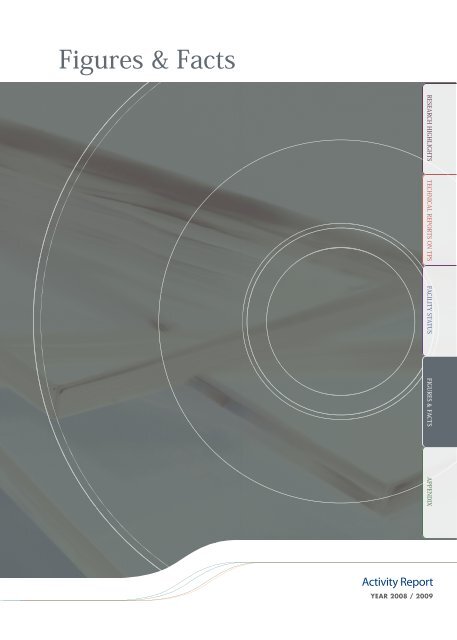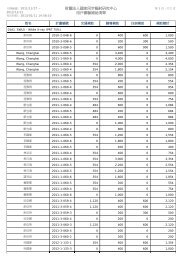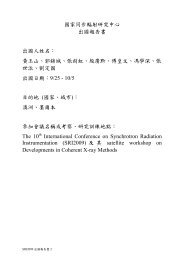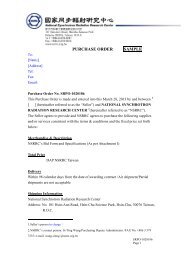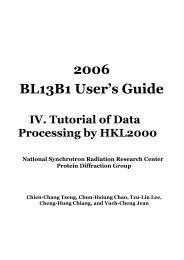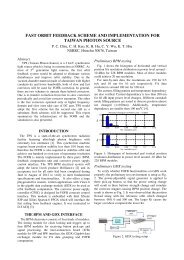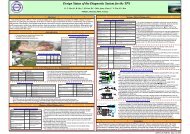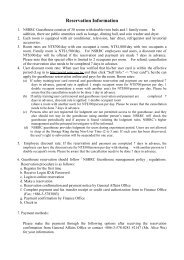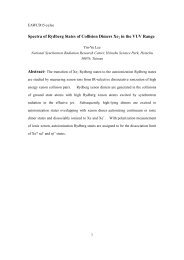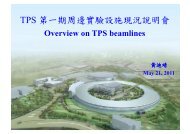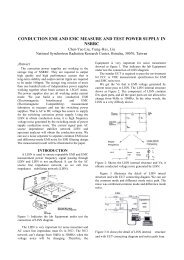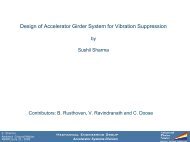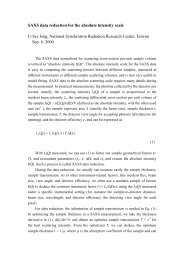Figures & Facts
Figures & Facts
Figures & Facts
Create successful ePaper yourself
Turn your PDF publications into a flip-book with our unique Google optimized e-Paper software.
<strong>Figures</strong> & <strong>Facts</strong><br />
Board of Trustees<br />
Dr. Lih J. Chen (Chairman), National Science Council<br />
Dr. Lou-Chuang Lee, National Science Council<br />
Dr. Yuan-Tseh Lee, Academia Sinica<br />
Dr. Samuel C. C. Ting, European Laboratory for Particle Physics<br />
(CERN), Switzerland<br />
Dr. Lee C. Teng, Academia Sinica<br />
Dr. Yuen-Ron Shen, University of California at Berkeley, USA<br />
Dr. Shie-Ming Peng, National Taiwan University<br />
Dr. Johnsee Lee, Industrial Technology Research Institute<br />
Dr. Kenneth K. Wu, National Health Research Institutes<br />
Dr. Andrew H.-J. Wang, Academia Sinica<br />
2009 User Executive Committee<br />
Dr. Yun-Liang Soo (Chairman), National Tsing Hua University<br />
Dr. Nei-Li Chan, National Taiwan University<br />
Dr. Di-Jing Huang, NSRRC<br />
Ms. Hsiao-Chi Lu, National Chiao Tung University<br />
Dr. Sheng-Rong Song, National Taiwan University<br />
Dr. An-Chung Su, National Tsing Hua University<br />
Dr. We-Fang Su, National Taiwan University<br />
Dr. Shu-Jung Tang, National Tsing Hua University<br />
Dr. Der-Hsin Wei, NSRRC<br />
Mr. Shih-Chang Weng, National Tsing Hua University<br />
Dr. Shih-Lin Chang, National Tsing-Hua University<br />
Dr. Chung-Yu Wu, National Chiao-Tug University<br />
Dr. Haydn H. D. Chen, Tunghai University<br />
Dr. Hung-Duen Yang, National Sun Yat-sen University<br />
Manpower<br />
As of March 2009, the NSRRC workforce consists of 298 staff members. The following pie charts show the manpower<br />
distributions by profession and by education background.<br />
132
<strong>Figures</strong> & <strong>Facts</strong><br />
Organization<br />
Organization for the TPS Project<br />
Safety Proposa<br />
133
<strong>Figures</strong> & <strong>Facts</strong><br />
Budget<br />
The NSRRC budget breaks down into nine sectors for the past seven years is presented below. It comprises Light<br />
Source & Instrumentation Development Divisions, Beamline & Research Divisions, ancillary expenditures of the above four<br />
divisions, SPring-8 group, Radiation & Operation Safety Division, Administrative Division including salaries & compensations,<br />
utilities & land lease, and civil construction. The total budget for fiscal year 2009 is 34.9 million US dollars (based on 2009<br />
currency, exchange rate: 1 USD=34 New Taiwan Dollars), a 6.85% decrease over that of the prior year.<br />
User Administration<br />
From 1994 to 2008, the total number of beamlines opened to the public users has increased from 4 to 22. During<br />
the year of 2008, the User Administration Office (UAO) handled 1,101 beam line proposals and 8,163 user runs. The total<br />
executed beamtime (excluding beamline maintenance and study) for TLS and SPring-8 beamlines is 12,264 shifts and<br />
767 shifts respectively. The UAO has issued 879 new user cards (including 687 new applications and 192 renewals), 2,712<br />
financial aids for students/<br />
Number of user-runs from 1994 to 2008<br />
postdocs, and 123 financial<br />
aids for SPring-8 experiments.<br />
T h e n u m b e r o f u s e r s i n<br />
2008 is 1,683 (254 Principal<br />
Investigators) drawn from 103<br />
affiliations (including 191 users<br />
from 55 foreign institutions).<br />
At the end of 2008, the NSRRC<br />
user community has 2,386<br />
active users (220 Principal<br />
Investigators). Operational<br />
d a t a o n b e a m l i n e s a n d<br />
users are summarized in the<br />
following figures.<br />
134
<strong>Figures</strong> & <strong>Facts</strong><br />
Beam time requested vs. allocated for different beamlines in Year 2008<br />
Number of VUV experiments from 1994 to 2008<br />
400<br />
350<br />
Experimental Runs<br />
300<br />
250<br />
200<br />
150<br />
100<br />
50<br />
0<br />
1994 1995 1996 1997 1998 1999 2000 2001 2002 2003 2004 2005 2006 2007 2008<br />
Year<br />
Number of X-ray experiments from 1996 to 2008<br />
1200<br />
Experimental Runs<br />
1000<br />
800<br />
600<br />
400<br />
200<br />
0<br />
1996 1997 1998 1999 2000 2001 2002 2003 2004 2005 2006 2007 2008<br />
Year<br />
135
<strong>Figures</strong> & <strong>Facts</strong><br />
Distribution of the users’ proposal in different experimental fields in 2008<br />
User Executive Committee<br />
The NSRRC’s User Executive Committee (UEC) was formed in the year of 1998. The UEC serves in an advisory capacity<br />
and communicates general users’ needs and concerns to NSRRC’s management. During 2008, under the leadership of UEC<br />
Chair Prof. Nei-Li Chan of National Taiwan University, UEC held four general business meetings. New UEC members elected<br />
are Prof. Sheng-Rong Song, National Taiwan University, Prof. Shu-Jung Tang, National Tsing Hua University; student: Mr. Shih-<br />
Chang Weng, National Tsing Hua University; Dr. Der-Hsin Wei, NSRRC.<br />
In year 2008, UEC and NSRRC jointly organized the Fourteenth Users’ Meeting & Workshop, which was held on October<br />
8 and 9, at National Synchrotron Radiation Research Center. In summary, there were 640 attendees, 8 invited talks and 207<br />
poster presentations during the meeting.<br />
136
<strong>Figures</strong> & <strong>Facts</strong><br />
Beamlines in Operation/Commissioning<br />
No. Name Mono. Type<br />
Energy Res. Power<br />
Range (eV) (E /ΔE)<br />
Status<br />
01A SWLS – White X-ray none > 5 k operation<br />
01B SWLS - Transmission X-ray Microscopy DCM 8 k – 11 k 1,000 operation<br />
01C SWLS - XAS/XRD DCM 6 k – 33 k 7,000 operation<br />
03A BM - High Flux VUV CGM 4 – 40 50,000 operation<br />
04B BM - SNM SNM 4 – 40 5,000 operation<br />
05A EPU - Soft X-ray Scattering AGM 400 – 1.5 k 20,000 operation<br />
05B EPU - Spin-polarized PES/PEEM SGM 60 – 1.5 k 20,000 operation<br />
08A BM - Low Energy SGM SGM 15 – 200 20,000 operation<br />
08B BM - Medium Energy AGM AGM 300 – 1 k 10,000 commissioning<br />
09A U5 - SPEM/Spectroscopy SGM 60 – 1.5 k 15,000 operation<br />
11A BM - Dragon SGM 8 – 1.5 k 15,000 operation<br />
13A SW6 - X-ray Scattering ACCM 12 k – 14 k 1,000 operation<br />
13B SW6 - Protein Crystallography-B DCM 5 k – 20 k 7,000 operation<br />
13C SW6 - Protein Crystallography-C ACCM 12 k – 14 k 1,000 operation<br />
14A BM - Infrared Microscopy FTIR 1 – 25 µm operation<br />
16A BM - Tender X-ray DCM 1 k – 9 k 7,000 operation<br />
17A W20 - X-ray Power Diffraction ACCM 8 k – 12 k 1,000 operation<br />
17B W20 - X-ray Scattering DCM 4 k – 15 k 7,000 operation<br />
17C W20 - XAS DCM 4 k – 15 k 7,000 operation<br />
18B BM - Micromachining none > 500 operation<br />
19A BM - X-ray Lithography none 800 – 1.8 k operation<br />
19B BM - Photo-stimulated Desorption none white light operation<br />
20A BM - High Energy SGM SGM 70 – 1.2 k 10,000 operation<br />
21A U9 - Chemical Dynamics none 4 – 500 50 operation<br />
21B U9 - Spectroscopy CGM 4 – 100 100,000 operation<br />
23A IASW - Small Angle X-ray Scattering DCM 5 k – 23 k 7,000 operation<br />
24A BM - Wide Range SGM SGM 10 – 1.5 k 30,000 operation<br />
SP12B Biostrucuture and Materials Research DCM 5 k – 100 k 7,000 operation<br />
SP12U Inelastic X-ray Scattering DCM/HRM 5 k – 30 k 1,000,000 operation<br />
SP12D HE photoemission DM/HRM 6 k – 14.4 k 300,000 commissioning<br />
Beamlines under Construction/in Planning<br />
No. Name Mono. Type<br />
Energy Res. Power<br />
Range (eV) (E /ΔE)<br />
Status<br />
04C BM - SRCD NIM 3 – 10 5,000->3,000 planning<br />
07A IASW - X-ray Scattering DCM 5 k – 23 k 7,000 construction<br />
15A IASW - X-ray Crystallography DCM 5 k – 14 k 7,000 construction<br />
ACCM: Asymmetric-cut Curved Crystal Monochromator<br />
AGM: Active Grating Monochromator<br />
CGM: Cylindrical Grating Monochromator<br />
DCM: Double Crystal Monochromator<br />
DM: Diamond Monochromator<br />
HRM: High Resolution Monochromator<br />
PEEM: Photoemission Electron Microscope<br />
SGM: Spherical Grating Monochromator<br />
SNM: Seya-Namioka Monochromator<br />
SPEM: Scanning Photoemission Electron Microscope<br />
SRCD: Synchrotron Radiation Circular Dichroism<br />
XRD: X-Ray Diffraction<br />
137
<strong>Figures</strong> & <strong>Facts</strong><br />
Spokespersons for Beamlines/End Stations (2009)<br />
No.<br />
Beamline<br />
Beamline<br />
End Station<br />
Tel ext.<br />
Spokespersons<br />
(Tel:886-3-578-0281)<br />
E-mail<br />
01A1 SWLS - White X-ray (PRT 75%) Hwu, Yeu-Kuang 1011 phhwu@sinica.edu.tw<br />
01B1 SWLS - X-ray Microscopy (PRT 75%) Song, Yen-Fang 1012 song@nsrrc.org.tw<br />
01C1 SWLS - EXAFS Chan, Ting-Shan 3289 chan.ts@nsrrc.org.tw<br />
01C2 SWLS - X-ray Powder Diffraction Sheu, Hwo-Shuenn 1013 hsheu@nsrrc.org.tw<br />
03A1 BM - (HF-CGM) - Gas Phase/Photoluminescence Cheng, Bing-Ming 1031 bmcheng@nsrrc.org.tw<br />
04B1 BM - (Seya) SRCD Chiang, Su-Yu 1042 schiang@nsrrc.org.tw<br />
05A1 EPU - Inelastic Scattering Huang, Di-Jing 1053 djhuang@nsrrc.org.tw<br />
05B1 EPU - Spin-polarized PES Huang, Di-Jing 1051 djhuang@nsrrc.org.tw<br />
05B2 EPU - PEEM Wei, Der-Hsin 1052 dhw@nsrrc.org.tw<br />
05B3 EPU - Soft X-ray Scattering Huang, Di-Jing 1053 djhuang@nsrrc.org.tw<br />
08A1 BM - (L-SGM) XPS, UPS Pi, Tun-Wen 1081 pi@nsrrc.org.tw<br />
09A1 U5 - SPEM Chen, Chia-Hao 1101 chchen@nsrrc.org.tw<br />
09A2 U5 - Spectroscopy Hsu, Yao-Jane 1101 yjhsu@nsrrc.org.tw<br />
11A1 BM - (Dragon) MCD, XAS (PRT 75%) Lin, Hong-Ji 1111 hjlin@nsrrc.org.tw<br />
13A1 SW6 - X-ray Scattering Lee, Ming-Tao 1131 mtlee@nsrrc.org.tw<br />
13B1 SW6 - Protein Crystallography Jean, Yuch-Cheng 1132 ycjean@nsrrc.org.tw<br />
13C1 SW6 - Protein Crystallography Chao, Frodo 1133 frodo@nsrrc.org.tw<br />
14A1 BM - IR Microscopy Lee, Yao-Chang 1141 yclee@nsrrc.org.tw<br />
16A1 BM - Tender X-ray Absorption, Diffraction Jang, Ling-Yun 1161 lyjang@nsrrc.org.tw<br />
17A1 W20 - X-ray Powder Diffraction Lee, Jey Jau 1171 jjlee@nsrrc.org.tw<br />
17B1 W20 - X-ray Scattering Lee, Hsin-Yi 1172 hylee@nsrrc.org.tw<br />
17C1 W20 - EXAFS Lee, Jyh-Fu 1173 jflee@nsrrc.org.tw<br />
18B1 BM - LIGA Shew, Bor-Yuan 1182 yuan@nsrrc.org.tw<br />
19A1 BM - X-ray Lithography Shew, Bor-Yuan 1191 yuan@nsrrc.org.tw<br />
20A1 BM - (H-SGM) XAS Chen, Jin-Ming 1201 jmchen@nsrrc.org.tw<br />
21A1 U9 - (White Light) Chemical Dynamics (PRT 75%) Lee, Shih-Huang 1211 shlee@nsrrc.org.tw<br />
21A2 U9 - (White Light) Photochemistry Cheng, Bing-Ming 1211 bmcheng@nsrrc.org.tw<br />
21B1 U9 - (CGM) Angle-Resolved UPS Lee, Yin-Yu 1212 yylee@nsrrc.org.tw<br />
21B2 U9 - Gas Phase Tsuei, Ku-Ding 1212 tsuei@nsrrc.org.tw<br />
23A1 IASW - Small/Wide Angle X-ray Scattering Jeng, U-Ser 1231 usjeng@nsrrc.org.tw<br />
24A1 BM - (WR-SGM) XPS, UPS Yang, Yaw-Wen 1241 yang@nsrrc.org.tw<br />
SP12B1 BM - Materials X-ray Study Ishii, Hirofumi h_ishii@spring8.or.jp<br />
SP12B2 BM - Protein X-ray Crystallography Chen, Chun-Jung cjchen@nsrrc.org.tw<br />
SP12U1 U3.2 - Inelastic X-ray Scattering Tsuei, Ku-Ding tsuei@nsrrc.org.tw<br />
138
<strong>Figures</strong> & <strong>Facts</strong><br />
2008 Machine Operation<br />
Energy : 1.5 GeV<br />
Current : top-up operation at 300 mA<br />
Lifetime : 4~7 hr @ 300mA, SWLS @ 5.0 Tesla, SW6 @ 3.2 Tesla, IASW @ 3.0 Tesla.<br />
Orbit stability : ~ 1 micron<br />
Orbit drift : ~ 3 micron / 8 hr<br />
Photon stability : better than 0.1% for 95% of user beam time<br />
User shifts: Tuesday 08:00 - Wednesday 24:00,<br />
Thursday 08:00 – Monday 08:00<br />
Up-time : > 97.9% (down-time due to unscheduled beam adjustment included)<br />
Mean time between failure: 112.3 hr<br />
The Taiwan Light Source delivered 5726 hr of scheduled user beam time with up-time 97.9 % in 2008. The accumulated<br />
machine down-time in 2008 was 118 hr, 70 hr due to unscheduled beam aborts and 48 hr due to requirements of beam<br />
adjustment. The average injection efficiency (from the transport line to the storage ring) is better than 80 % in the user<br />
beam time, with an average cumulative radiation dose of 2.1 mSv/year in 2008 measured with dosimeters mounted on the<br />
outer shielding walls of six straight sections of the storage ring in the experimental hall of TLS. The average variation of topup<br />
beam current is better than 1.5% in rms. More than 95 % of beam time has fluctuations of synchrotron light intensity<br />
less than 0.1%, and there are two I 0 spikes per user shift (8 hr of user beam time) in average in 2008.<br />
Operational Performance of Taiwan Light Source<br />
YEAR /TLS<br />
User Time<br />
Scheduled Annual<br />
Up-time<br />
User Time [hr]<br />
MTBF<br />
[hr]<br />
Operation Mode<br />
I 0 Stability<br />
(ΔI 0 / I 0 < 0.1%)<br />
2002 4785 95.8% 154.4 Decay Mode 47%<br />
2003 5017 97.2% 313.6 Decay Mode 86%<br />
2004 4235 97.5% 69.4 Decay Mode 85%<br />
2005 4576 96.8% 83.2 SRF/Top-up Mode (3/12) 76%<br />
2006 5552 96.7% 40.8 SRF/Top-up Mode 81.3% (98.1% of ΔI 0 / I 0 < 0.2%)<br />
2007 5219 98.1% 85.6 SRF/Top-up Mode 39.9% (98.0% of ΔI 0 / I 0 < 0.2%)<br />
2008 5726 97.9% 112.3 SRF/Top-up Mode 95.7% (98.0% of ΔI 0 / I 0 < 0.2%)<br />
Major Events in Year 2008<br />
January 2008<br />
The Second TPS Machine Advisory Committee<br />
Meeting<br />
The 2nd Machine Advisor y Committee (MAC)<br />
convened for its 2nd meeting on January 9-10, 2008<br />
at NSRRC to review the present planning status for the<br />
Taiwan Photon Source (TPS). In a series of presentations,<br />
the committee was given an overview of the project<br />
and insight of the beam dynamics, injection systems,<br />
conventional construction plans, conceptual technical<br />
design, and integration plans. The committee members<br />
were very much impressed by the thoroughness and<br />
quality of the planning and presentations as well as by the<br />
large amount of preparatory work that has been invested<br />
to optimize the design of the TPS. The MAC was pleased<br />
to note that important decisions have been made since<br />
139
<strong>Figures</strong> & <strong>Facts</strong><br />
the last MAC-meeting. It has been decided to use the DBA<br />
as the lattice for the TPS, all straight sections have been<br />
increased, the injector shall be a concentric ring sharing<br />
the storage ring tunnel and there will be an overhead<br />
crane. The MAC agreed with these decisions allowing<br />
concentration on more detailed studies.<br />
The MAC is expecting a further discussion during the<br />
next meeting. Specifically, the MAC is now eager to learn<br />
more about the management plans for this project, the<br />
TPS project manager, budget, cost estimates, schedules,<br />
and milestones to the extent that they impact directly the<br />
health of the TPS project.<br />
out that "As the particle shred size down to nano scale<br />
using NanoCocrystallineOlivine technology (LFP-NCOTEC),<br />
the powder coating becomes a problem". To solve the<br />
coating problem, Aleees tried to make the secondary<br />
particle to 15 µm in dimension, which included the primary<br />
particle about 100 nm ~ 200 nm. This morphology not<br />
only has better conductivity but also stores more power in<br />
the same volume.<br />
Following the workshop, there was a brief ceremony<br />
for signing of the MOU. The CEO of Aleees, Mr. Jack<br />
Wang, re-stated the philosophy behind Aleees battery,<br />
Human Safe and Eco Friendly, as the driving force for<br />
their innovation and a dream for turning the polluted<br />
environment into a green land for future generations. Dr.<br />
Keng Liang, director of the NSRRC, echoed such message<br />
and confirmed NSRRC's support for domestic researchers<br />
who are determined to pursue such technology<br />
breakthrough. The collaborative agreement between<br />
Aleees and NSRRC was the first industrial agreement<br />
achieved by NSRRC’s Industrial Application Office, which<br />
was formed in August 2007.<br />
A briefing by the Deputy Director of NSRRC, Dr. Luo, on the<br />
2nd MAC meeting<br />
January 2008<br />
Aleees and NSRRC Entered a Collaborative<br />
Agreement<br />
ALECL (Advanced Lithium Electrochemistry Co., Ltd.)<br />
also known as Aleees, and NSRRC are corporating on<br />
advancing the nano-LFP battery technology. On January<br />
29, 2008, Aleees and the NSRRC entered a collaborative<br />
agreement to work on the advancement on Nano-LFP<br />
battery technology and new materials for battery that are<br />
eco and environmental friendly. The ceremony started<br />
with a workshop followed by the MOU signing event at<br />
NSRRC.<br />
Mr. T. L. Wang (ALECL, left) and Dr. K. Liang ( NSRRC)<br />
Dr. B. J. Liao of Aleees delivered a highlight on the<br />
investigation of synthesis and characterization of LiFePO 4<br />
cathode materials in the workshop. He shared with the<br />
audience the challenges they had encountered during the<br />
course of creating a better cathode material. He pointed<br />
Group photo<br />
140
<strong>Figures</strong> & <strong>Facts</strong><br />
Febrary 2008<br />
NSRRC Evaluates EPICS as the Possible Choice for its<br />
Future Accelerator<br />
An EPICS (Experimental Physics and Industrial Control<br />
System) training course is held to give control specialists<br />
an overview of its implementations in the control system<br />
of the accelerator from February 18 to 27. NSRRC staff of<br />
the Instrumentation & Control Group (IC group), RF Group,<br />
and Beamline Group have geared up on putting plans and<br />
tasks in place for Taiwan Photon Source (TPS), the next<br />
accelerator that is presently scheduled to have groundbreaking<br />
construction at around the end of 2009.<br />
One of the key agenda is to fully evaluate available<br />
software that will be adopted as the backbone of the<br />
control systems for the accelerator. Programs include<br />
lectures, which are offered by a service provider, and<br />
intensive hand-on experiments. Staff has run through<br />
examples to build prototypes and to simulate the<br />
control system with parameters designed for the future<br />
accelerator.<br />
speed up the processing of experimental data of NSRRC<br />
users, was offered on March 6. Getting new users to learn<br />
old tricks is one of the tasks the NSRRC beamline managers<br />
deal with every single day. Facing the increasing number<br />
of users each year that leads to shorter time slot granted to<br />
each research team, solutions were compiled and carried<br />
out in recent months. As a result, users see more hand-on<br />
training offered by NSRRC staff beginning 2008.<br />
30 students in the class were required to study the<br />
class material and to download the needed programs<br />
beforehand. The course began with the installation of<br />
GSAS and EXPGUI. Next, each person used their own XRD<br />
experimental data to feed the systems for exercise. To run<br />
the programs, each trainee is also required to gather cell<br />
parameters, space group, and atomic coordinates as inputs.<br />
If unavailable, the built-in examples were then used<br />
instead.<br />
The training course produced a set of feedback and<br />
hit-and-miss score cards for fitting into the review process<br />
of a (or more) programmable software solutions of the<br />
control systems.<br />
GSAS Training Course<br />
April 2008<br />
2008 Synchrotron Radiation Protein<br />
Crystallography Workshop<br />
EPICS Training Course<br />
March 2008<br />
A One-day GSAS Training Offers NSRRC Users a<br />
Quick-start of Mastering the Analytical Tool<br />
Generalized Structure and Analysis Software (GSAS)<br />
EXPGUI, a graphical user interface for GSAS, which can<br />
Automation on Protein Crystallography Beamlines<br />
at NSRRC<br />
A two-day workshop on Automation on Protein<br />
Crystallography Beamlines at NSRRC was held at NSRRC<br />
on April 9 - 10. There were 23 attendees in total as registration<br />
was limited to one representative per user<br />
group.<br />
141
<strong>Figures</strong> & <strong>Facts</strong><br />
The purpose of this workshop is to introduce the<br />
latest developments of high-throughput techniques<br />
on protein crystallography beamlines at NSRRC and to<br />
help users in familiarizing with the automatic devices.<br />
Topics such as robotic sample mounting, automated loop<br />
centering, and crystal screening software were presented.<br />
These new developments should simplify data collection<br />
and structure determination at NSRRC.<br />
Overall, the workshop was successful and interaction<br />
among the attendees were enthusiastic.<br />
Interaction among the attendees during the workshop.<br />
April 2008<br />
Launch of NSRRC’s Southern Taiwan Office<br />
On April 30, 2008, NSRRC established the southern<br />
Taiwan office at National Cheng Kung University (hereafter<br />
referred to as NCKU) in Tainan. This is the second office<br />
that NSRRC established outside its Hsinchu site. The first<br />
off-site office was established in 2001 at Harima Science<br />
Park City, Hyogo, where the main synchrotron radiation<br />
research center in Japan, SPring-8, is located.<br />
Through the establishment of southern Taiwan office<br />
at NCKU, scholars and students can easily find the channel<br />
to understand how to utilize world-class synchrotron<br />
radiation light source at NSRRC for scientific research. The<br />
southern Taiwan office is located on the fifth floor of Yien-<br />
Ping admin. building of NCKU.<br />
NSRRC inaugurated the southern Taiwan office<br />
May 2008<br />
Organization Restructure<br />
In order to gear up for the Taiwan photon source<br />
project ( TPS) and to make maximum use of existing<br />
resources of the Taiwan Light Source (TLS) to make TPS<br />
one of the first-class experiment facilities, the organization<br />
of NSRRC has been modified slightly starting May 1st. The<br />
Beamline Division has been changed into Experimental<br />
Facility Division with the aim in developing experimental<br />
facilities for advanced light source and in strengtening the<br />
cooperation with outstanding users; the Research Division<br />
has been changed into Scientific Research Division with<br />
the aim in promoting dominant study so scientific research<br />
break-through in synchrotron related fields can be made<br />
possible.<br />
May 2008<br />
Shuttle Service among NTHU, NHRI and NSRRC<br />
In order to strengthen the international cooperation<br />
program and academic research interchange among<br />
National Tsing Hua University (NTHU), National Health<br />
Research Institutes (NHRI), and NSRRC and also to make it<br />
more convenient for students and users to travel between<br />
these institutions, new shuttle bus route was added as of<br />
May 1, 2008.<br />
May 2008<br />
Utility Mini-workshop for TPS Project<br />
A “Mini-workshop of Utility System for TPS Project”<br />
was held on May 15-16, 2008 at NSRRC to examine the<br />
utility system design for the TPS project and to collect<br />
142
<strong>Figures</strong> & <strong>Facts</strong><br />
suggestions and advise for improvement in design.<br />
Director, Dr. Keng Liang, first presented the current status<br />
of the TPS project, and then followed by the introduction<br />
of the current status of the civil construction plan, the<br />
accelerator engineering design, and the utility system<br />
design for the TPS project by NSRRC staff.<br />
Five abroad experts were invited to join this miniworkshop<br />
and they presented civil and utility system<br />
design or operation experience of their own facility. There<br />
are about 40 attendees and the following prospects were<br />
achieved at this mini-workshop:<br />
1. Reviewing the design of the utility system of the TPS<br />
project.<br />
2. The general requirement and capacity estimation of<br />
the utility system for the synchrotron facility and the<br />
accelerator laboratories.<br />
3. The correlation between the stability of the utility<br />
system and the beam performance (prevention of<br />
operation interruption, trip rate related to utilities,<br />
photon stability, and orbit stability, etc.).<br />
4. Grounding, electronics noise reduction and vibration<br />
suppression due to the water flow.<br />
Many constructive and valuable comments were<br />
obtained through this mini-workshop and the utility<br />
system design was modified accordingly.<br />
been set up. The main task of this committee is to plan for<br />
the development direction of NSRRC’s scientific research<br />
and accelerator technology and other related matters.<br />
The 1st Academic Development Committee members<br />
are Di-Jing Huang (Chairman), Jin-Ming Chen, Yaw-Wen<br />
Yang, Mau-Tsu Tang, Bing-Ming Cheng, Chun-Jung Chen,<br />
Chin-Cheng Kuo, and Ching-Shiang Hwang and the first<br />
committee meeting was held on May 22.<br />
June 2008<br />
2008 Protein Crystallography Training Course<br />
A six-day Protein Crystallography Training Course was<br />
successfully held at NSRRC from June 25th to July 2nd.<br />
This training course is restricted to domestic user who has<br />
no experience in applying this technique and needs to use<br />
it in the near future. The goal of this training course is to<br />
disseminate experimental techniques of macromolecular<br />
crystallography to researchers or graduate student with an<br />
interest in using this specific method to further extend the<br />
scope of their research.<br />
This course covers broad spectrum of topics on<br />
synchrotron-based protein crystallography ranging<br />
from crystallization of proteins, data collection strategy,<br />
phasing techniques, radiation damage on protein crystals,<br />
to structure determination of proteins. Every attendee<br />
practices how to grow crystal, collect diffraction data,<br />
process data, and determine the structure of Insulin by<br />
S-SAD method all by themselves.<br />
Group photo of Mini-workshop of Utility System for TPS<br />
Project<br />
May 2008<br />
Set up Academic Development Committee<br />
For the long-term planning of NSRRC’s academic<br />
development, the Academic Development Committee has<br />
Attendees on the Training course<br />
143
<strong>Figures</strong> & <strong>Facts</strong><br />
July 2008<br />
The Third TPS Machine Advisory Committee<br />
Meeting<br />
The NSRRC Machine Advisory Committee (MAC)<br />
convened for its 3rd meeting on July 7-8 at NSRRC to<br />
review the present planning status for the Taiwan Photon<br />
Source (TPS). In a series of presentations, the Committee<br />
was given more detailed insight into particular areas of<br />
the project. The Committee was very much impressed<br />
by the thoroughness and quality of the planning<br />
and presentations as well as by the large amount of<br />
preparatory work that has been invested in the design of<br />
the TPS. There seems no work left to be done that could<br />
potentially become a show stopper. All designs and<br />
systems are very well underway and promise successful<br />
completion. The committee congratulates the NSRRC<br />
team for their work and focus on the challenges of the TPS.<br />
The MAC is pleased to note that the project<br />
management is in place and working hard to integrate<br />
all subsystems. The management functions in a matrix<br />
organization, where TPS tasks are executed by established<br />
TLS groups.<br />
August 2008<br />
The summer school of the Applications on<br />
Synchrotron Light Source<br />
A three-credit summer school of the Applications<br />
on Synchrotron Light Source is held jointly by NSRRC<br />
and National Tsing Hua University (NTHU) from Aug. 5<br />
to 19. The classes are conducted by Dr. Chih-Hao Lee,<br />
who is a professor of Department of Engineering and<br />
System Science of NTHU, together with 19 colleagues of<br />
NSRRC. The purpose of this course is to introduce the<br />
synchrotron light source, facility, and related research<br />
applications to undergraduate students so as to enhance<br />
their understanding of synchrotron light source. In total,<br />
68 students have registered for the course and 52 students<br />
have been selected to attend the classes along with 3 sit in<br />
students.<br />
Students on the class<br />
September 2008<br />
The fifth OCPA Accelerator School in Chitou at<br />
Youth Activity Center<br />
The fifth OCPA Accelerator School was held on<br />
September 1-10 in Chitou Youth Activity Center, Nantou<br />
County, Taiwan. The program invited 28 speakers from<br />
both domestic and internationally renowned experts in<br />
the field of accelerators. Topics covered in the program<br />
include those encountered in the operation of existing<br />
accelerators and accelerators that have been proposed and<br />
are under construction. Subjects including synchrotron<br />
radiation, high energy physics, spallation neutrons, heavy<br />
ions, and medical applications were emphasized. Tutorial<br />
sessions were set aside from the formal course sessions<br />
to consolidate the learning. There were 65 participants<br />
for this program, including 36 from Taiwan and 29 from<br />
mainland China.<br />
Attendees on the Training course<br />
144
<strong>Figures</strong> & <strong>Facts</strong><br />
September 2008<br />
The XBPM and Beam Stability mini workshop<br />
The XBPM and Beam Stability mini workshop is<br />
held on September 11-12, 2008, at NSRRC. The purpose<br />
of the mini workshop is for experience accumulation<br />
and information exchange in order to develop new<br />
generation of photon beam position monitor as well as<br />
its improvement to beam stability, particularly for Taiwan<br />
Photon Source (TPS).<br />
Besides speakers from NSRRC, the workshop<br />
brought together 9 experts from Europe, United States,<br />
and Japan. The workshop includes three XBPM related<br />
sessions: overall view, beam physics, and control system.<br />
Recent development and measurement experiences<br />
from SPring-8, APS, BNL, DLS, SLAC/SSRL, and NSRRC are<br />
presented.<br />
The group photo of workshop attendees<br />
October 2008<br />
The 14th User’s Meeting and Workshop<br />
The 14th User ’s Meeting and Workshop were<br />
successfully held on October 8-9. Several distinguished<br />
speakers were invited to share with all the attendees their<br />
cutting-edge research. In order to encourage interactions<br />
among attendees, English was used as the official language<br />
during the meeting, except at the Users’ Town Meeting.<br />
There were 640 attendees with 207 poster presentations<br />
for the event.<br />
On O c tober 9, one workshop, entitled X-ray<br />
Crystallography / Spectroscopy was held. This workshop<br />
highlighted the synchrotron applications in the cuttingedge<br />
research of X-ray crystallography and spectroscopy,<br />
including free electron laser, time-resolved protein<br />
crystallography, iron sulfur protein, protein folding<br />
dynamics, X-ray scattering and small angle scattering,<br />
high-resolution powder diffraction, and renewable energy<br />
science. In addition, six interest group meetings were<br />
held during lunch time. Users attended the interest group<br />
meetings according to their research fields to explore new<br />
research opportunities.<br />
October 2008<br />
A technical review meeting of TPS<br />
A technical review meeting for reviewing the detailed<br />
design of the vacuum system for the Taiwan Photon<br />
Source (TPS) was held on October 23, at High Energy<br />
Accelerator Research Organization (KEK), Tsukuba, Japan.<br />
The vacuum experts from the facilities of SPring-8, PF, PF-<br />
AR, KEK B-Factory, J-PARC, and Univ. of Tokyo were invited<br />
to attend the meeting. After five presentations on TPS<br />
by the members of vacuum group of NSRRC and one<br />
invited talk on pulsed sextupole magnet (PSM) by Prof.<br />
H. Takaki of ISSP of Univ. Tokyo, the reviewing members<br />
were much impressed by the thoroughness and quality<br />
of the planning and the design of the vacuum system.<br />
They also encouraged the team to complete the design<br />
by improving the conceptual designs with real ones<br />
according to the detailed specifications as possible since<br />
the design criteria presented were appropriate.<br />
December 2008<br />
First stage review of the Letter of Interest for TPS<br />
After several discussions with the users and the<br />
representing committee, the phase-I (up to year 2013)<br />
planning of the Taiwan Photon Source project (TPS) has<br />
gradually developed. In August 2008, NSRRC has sent out<br />
the “Call for Letter of Interest (LOI)” announcement via<br />
e-mail to universities and main research institutions. And<br />
interested party was asked to submit the LOI in the name<br />
of the organization. By the end of September 2008, a<br />
total of 12 LOIs have been received from Academia Sinica,<br />
National Taiwan University, National Tsing Hua University,<br />
145
<strong>Figures</strong> & <strong>Facts</strong><br />
National Cheng Kung University, and Tunghai University.<br />
After the first round of review by international experts<br />
specialized in beamlines in December 2008, 11 out of 12<br />
LOIs have been accepted for second stage review.<br />
The second stage review of the LOI was completed<br />
at the Science Advisory Committee (SAC) meeting held at<br />
NSRRC in January 2009. The committee has scheduled to<br />
perform the third stage review in September 2009 and a<br />
final confirmation shall be made for the 5 beamlines for<br />
phase-I planning.<br />
of liquid helium during cavity operation. The construction<br />
of a new cryogenic system with a refrigeration capacity<br />
of 700 W is planned to cool all superconducting cavities.<br />
The 700W cryogenic system was contracted out to Linde<br />
in January 2009 and the delivery of the new cryogenic<br />
system is foreseen to be in May 2011. Acceptance test of<br />
the system will be finished in December 2011.<br />
December 2008<br />
Purchasing order made for 3 main systems of TPS<br />
During the end of 2008 and the beginning of 2009,<br />
the purchasing order for three main systems of TPS, which<br />
included the linac, the RF transmitter, and the cryogenic<br />
system, has been made.<br />
The linac consists of an electron gun, focusing and<br />
bunching section, and accelerating section. The electron<br />
gun is capable of providing pulsed nano-second electrons<br />
with energy of 90 keV. Then, the electrons are further<br />
focused and longitudinally bunched and transferred to the<br />
accelerating section. The 20 meters accelerating section<br />
is composed of three accelerating structures, equipping<br />
with three high-power microwave amplifiers, in which the<br />
electrons are accelerated close to the speed of light with<br />
energy of 150 MeV. The linac was contracted to ACCEL in<br />
November 2008.<br />
The RF transmitter is the high-power source of the<br />
RF system. It mainly consists of klystron, high-voltage<br />
power supply, electronics and protection circuits. The<br />
switching type high-voltage power supply benefits the<br />
operation reliability and thus is selected. Three 500-MHz<br />
RF transmitters, each with capacity above 250 kW, are<br />
foreseen for the first-stage operation of the TPS storage<br />
ring. Two 300-kW transmitters were contracted to THALES<br />
in November.<br />
In the TPS project, the installation of four 500 MHz<br />
superconducting cavities of the single-cell type is planned.<br />
Each cavity cryostat has a volume of 500 l and stores 400 l<br />
146


